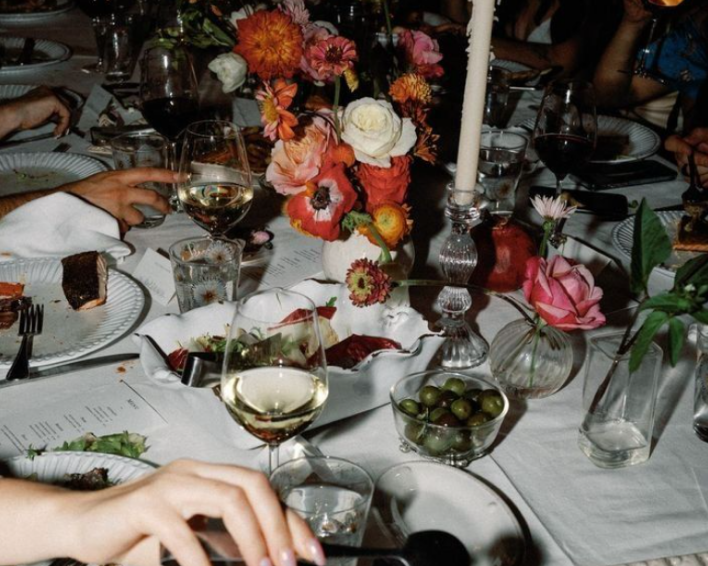Hosting a dinner party is part ritual, part magic. It’s about more than good food or a perfectly curated playlist—it’s the mood you create from the moment someone steps through your door. That unmistakable feeling of being held, welcomed, and completely at ease.
And one of the most powerful (yet overlooked) tools for setting that scene? Scent.
Welcome to the art of scent-scaping—using fragrance to shape the atmosphere of your space as the evening unfolds. It’s about layering scents with intention, creating gentle transitions from room to room, and using candles to tell a story—without saying a word.
Here’s how to do it well, without overdoing it.
How to Scent Your Entrance for a Dinner Party
First things first: the entrance. This is your olfactory handshake—the moment that says, you’ve arrived. You want something fresh, uplifting, and inviting, without being overwhelming.
Scents like basil, bergamot, tomato leaf, or minty greens are perfect here. They feel light and modern, like opening a window on a crisp day. The goal? To cut through the outside world and set the tone for what’s to come.
Tip: Light your hallway candle 30–45 minutes before guests arrive. You want the fragrance to be ambient, not obvious.
Should You Use Scented Candles at the Dinner Table?
It’s tempting to place a beautiful scented candle at the centre of your table—but for the sake of your food, don’t.
Fragrance has a powerful effect on taste. A strong scent can mask delicate flavours or throw off your palate entirely. That lemon and cedar candle might smell divine on its own—but not next to a slow-cooked ragu.
Instead, bring fragrance into the room subtly. A candle on a nearby sideboard, windowsill or console can set the mood around the space without interfering with what’s on the plate. On the table itself? Stick to unscented tapers or tealights and let the glow do the talking.
How to Layer Home Fragrance Throughout Your Dinner Party
Think of your dinner party as a scent arc—each space a chapter, each candle a shift in mood.
Start in the hallway with something green and crisp. As guests move into the living room post-dinner, ease into softer, cocooning notes—fig leaf, sandalwood, violet, or musk all work beautifully here. These scents don’t demand attention, but they hold the space gently.
Later, you can deepen the mood with a warmer fragrance—oakmoss, pear or tonka—as conversation slows and the evening begins to settle. You don’t need to go overboard. One quiet change is enough to subtly mark the shift from supper to wind-down.
Another way to play with scent is to bring in the season. Spring and summer call for bright, herbal blends; autumn invites warmth, spice and earthy woods. Just like with food or flowers, seasonal scenting helps create a moment that feels anchored and thoughtful.
The Best Places to Add Fragrance for Hosting (Yes, Even the Bathroom)
This one’s often overlooked—but makes a lasting impression.
The guest bathroom is a quiet interlude during a lively evening. A small candle or reed diffuser here, with spa-like notes—jasmine, bamboo, eucalyptus or mint—can make the space feel calm and intentional.
It shows attention to detail without trying too hard. It’s a soft little I thought of this too moment.
When to Light Candles for a Dinner Party (And When to Switch Scents)
As with lighting and music, timing matters. Light your entry and background candles ahead of time to let the scent settle. Let your guests arrive into an atmosphere that feels lived-in and effortless.
Later in the evening—post-dessert, maybe as coats are staying off and another bottle is opened—you can gently shift the mood. Swap your fresh candle for something darker, more grounded. Something that says, we’re not rushing off just yet.
How Many Candles Is Too Many? Scenting Your Home Subtly
This isn’t a perfume counter. You want whispers, not full-blown announcements.
Stick to one or two beautifully made candles—max three, if you’re working with a larger space. Focus on natural wax and well-balanced blends. Synthetic-heavy scents tend to linger in all the wrong ways—and can clash with the food and mood.
Trust your nose. If it’s already strong before anyone arrives, it’ll be too much with a full room and warm plates.
Simple Candle Scent Plan for Your Next Dinner Party
Not sure where to start? Here’s a simple, elegant set-up that works for almost any dinner party:
-
Hallway or entrance – Light a fresh, green candle: basil, tomato leaf, bergamot or something citrusy.
-
Dining space – Use unscented tapers or tealights. If you like, add a softly-scented candle on a sideboard in fig, musk or sandalwood.
-
Bathroom – A small reed diffuser or candle in something calm and clean—bamboo, lavender, or jasmine.
-
Living room – After dinner, introduce a deeper note like tonka, honey amber, or oakmoss to signal relaxed engagement.
That’s it. Two or three candles, max. No stress. No scent overload. Just a quiet sense of intention that elevates everything.
Why Scent-Scaping Is the Secret to a Memorable Dinner Party
Scent-scaping isn’t about perfection—it’s about presence. It’s a way to set a scene, guide the rhythm of the evening, and make people feel held by the space you’ve created.
So light the candle. Pour the wine. And let the fragrance tell the story you don’t need to.



